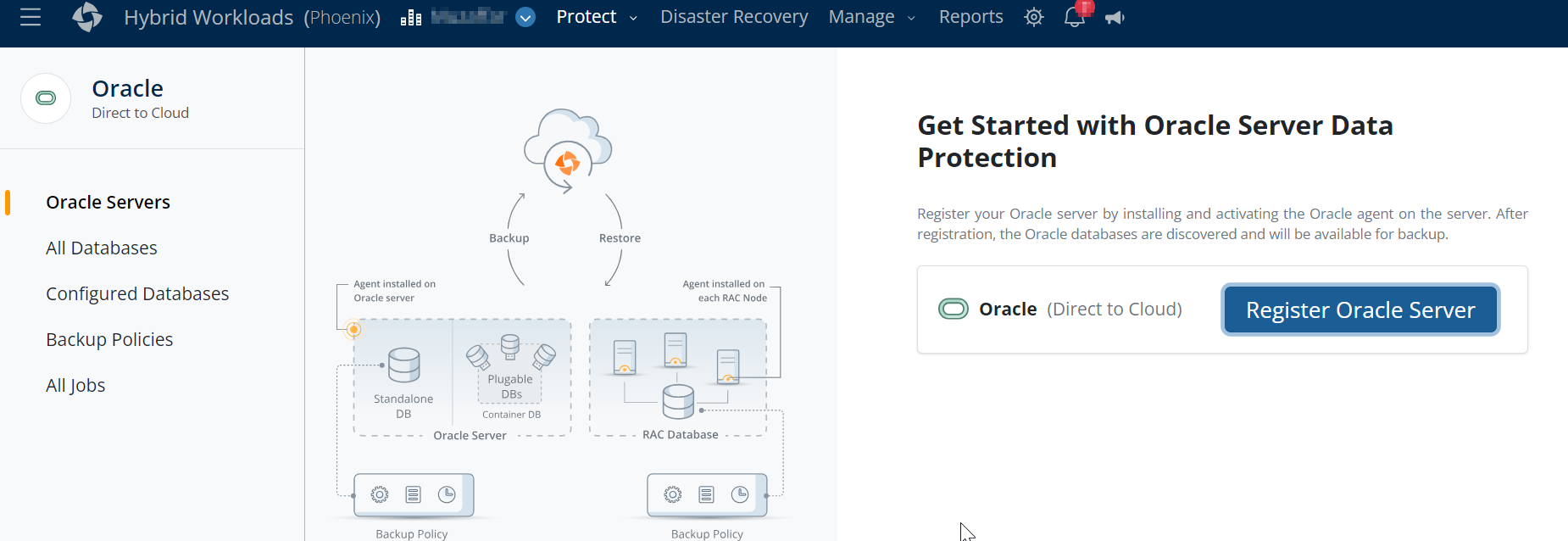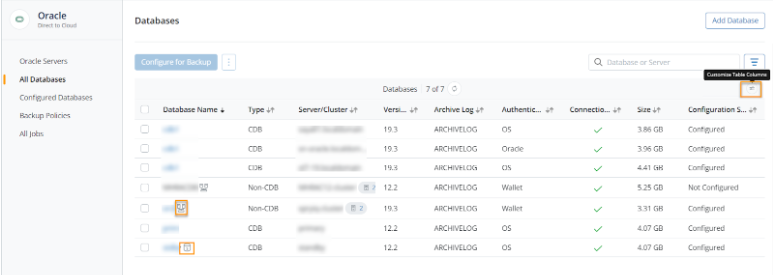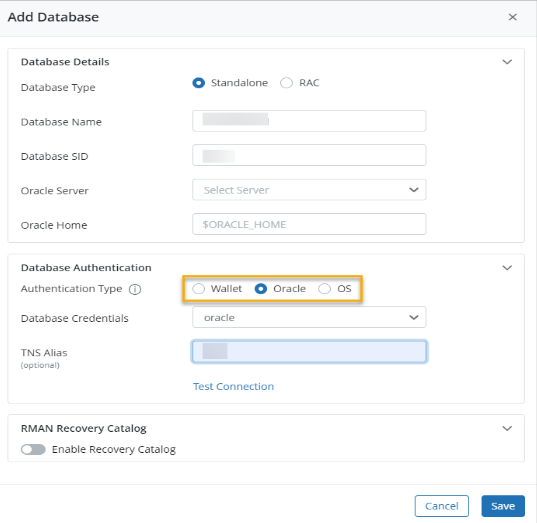User Guide - Preparing your environment for successful Druva Oracle DTC Backup
One-stop solution
This document provides a clear, step-by-step guide that focuses on how to prepare and configure backups of Oracle databases. Follow these instructions to effectively manage your backups using the Druva DTC Agent.
Purpose
Prepare the environment for Druva DTC Agent to have successful backups of Oracle databases
- ►1. What is Oracle server?
-
- Oracle Corporation created the widely used Relational Database Management System (RDBMS), known as Oracle. It's designed to store, manage, and retrieve data efficiently, making it a fundamental component of many enterprise-level applications and systems. Here are some of its various components:
- Instance: An Oracle instance is the software and memory structures that manage database operations.
- Database: The database itself is a collection of physical files on the disk that store data. It includes data files, control files, and redo log files.
- SQL (Structured Query Language) is the language used to interact with an Oracle database. Users and applications issue SQL statements to query and manipulate data.
- Listener: The Oracle Listener is a process that listens for incoming client connection requests and establishes a connection between clients and the Oracle database.
- Oracle Net Services: It provides network communication services for Oracle Database. It includes protocols and tools for connecting to the database from different locations.
- Redo Log Files: These files store a record of all changes made to the database. They are crucial for recovery in the event of system failures.
- Control Files: Control files contain metadata about the physical structure of the database. They are critical for database startup and recovery.
- Archived Redo Logs: These are copies of the redo log files that have been archived. They are used for backup and recovery purposes.
- Backup and Recovery Components: Oracle includes various tools and utilities for creating backups and recovering data in case of data loss or system failures. These include RMAN (Recovery Manager) and Data Pump.
- ►2. Why perform a Oracle database backup?
-
- Protect your data from accidents, mistakes, or computer problems.
- Ensure you can recover your data if something bad happens, like a computer crash or a disaster like a fire or flood.
- Keep old data for analyzing trends or reporting.
- Increase security by having a safe copy of your data even if someone tries to steal it.
- ►3. What does Druva back up from Oracle Servers?
-
- Druva radically simplifies the backup and recovery of Oracle databases hosted on on-premise physical and virtual infrastructure, as well as cloud infrastructure such as Amazon EC2, Azure VMs, Google Compute Engines, and so on.
- Druva allows you to back up and recover the following databases running on the Oracle Server hosts:(Click Here)
- Container databases: Container databases support multi-tenancy. A CDB comprises control files, data files, temporary files, undo records, archived logs, and a data dictionary specific to its objects.
- Pluggable databases: A single CDB may host zero, one, or more pluggable databases (PDB). A PDB comprises data files and temporary files, and owns a data dictionary specific to its objects.
- Standalone databases
- RAC databases
- Physical Standby databases
- ►4. What is the Oracle database backup workflow? What are the types of backup methods?
-
- For more information on the database backup workflow, (Click here)
- Type of database backup method:
- Full backup
- Incremental backup
- Archive Log backup
- ►5. What are the requirements before you run an installation for Druva Oracle DTC Agent ?
-
- Prerequisites: Prerequisites_for_Oracle_servers
- System Requirements: System requirements for Oracle Server
Oracle DTC agent is available for Linux environments only
- ►6. Where should I download the for Druva Oracle DTC Agent from?
-
- You can download the Windows installer using one of the following three methods:
- Downloads Page
- Settings Page

- Management Console -> Protect -> Oracle ->Oracle DTC -> Register Oracle Server

-
Directly download the installer on the Linux server by copying the download link and using the wget command:
-

- You can download the Windows installer using one of the following three methods:
- ►7. How do I install the Druva Oracle DTC Agent ?
-
- Copy the downloaded setup file to the Oracle server using WinSCP or any other tool.
- Follow the process detailed in the Installation article.
- Once installed, verify that the Phoenix service is in running mode using below command
- (systemctl status: PhoenixOracle)
- ►8. How do I activate for Druva Oracle DTC Agent?
-
- The step-by-step process is outlined in the Activation article.
- Once activated, the server is listed on the Oracle Servers page.
- (Management Console -> Protect->Oracle > Oracle > Direct to Cloud ->Oracle Servers)

- Once the connection status is showing green and connected, then it automatically discovers the databases or can use the instructions given under this article: Discover Database
- Discover databases are not yet ready for backup. We must configure databases to backup to the Druva cloud.
- ►9. How do I configure Oracle Database backups in Druva?
-
- After activation, Navigate to “All databases” tab

- Before configuring the database for backup, we need to assign authentication to the database.

- When we click Assign option in the above screenshot, we get below “Add Database” screen

- Select Authentication Type and Test Connection
- Once the test connection is successful, click on save.
- Once authentication is assigned to the database, select the check box next to the database name and Click on “Configure for Backup.”

- Configured Databases: Set of Content Rules and Backup Policy
- Backup policy: How to backup ? (Backup Window, Schedule, Frequency, Retention, Bandwidth, RMAN Settings)
- Note: At the time of creating or configuring the backup policy, make sure to create a separate policy for archive log enabled and no archive log database.
- ARCHIVELOG mode allows for continuous backups and point-in-time recovery, while NOARCHIVELOG mode permits only offline backups and lacks point-in-time recovery capability.
- After activation, Navigate to “All databases” tab
- ►10. What are the prerequisites before you start a backup of configured Oracle Database backup?
-
Verify the pre-checks on the server where the Oracle DTC agent is installed.
- Connection
- Verify the connection between the server and Druva.
(Use command prompt or powershell) - Below are the additional commands to verify
- nslookup backup-phoenix.druva.com
- telnet backup-phoenix.druva.com 443
- curl -v -k backup-phoenix.druva.com:443
- Openssl s_client -connect backup-phoenix.druva.com:443 -showcerts
- Verify the connection between the server and Druva.
- Service
- The service “Phoenix” should be in Running mode.
(systemctl status PhoenixOracle) 
If it is not running, then use the below command to start or restart it.
(systemctl start PhoenixOracle)or(systemctl restart PhoenixOracle)
- The service “Phoenix” should be in Running mode.
- UI Status
- The status of the SQL Resource on Druva console should show as “Connected”.

- The status of the SQL Resource on Druva console should show as “Connected”.
-
Database level
- Make sure to enable Block Change tracking (BCT) before the backup. ALTER DATABASE; ENABLE BLOCK CHANGE TRACKING;
- By default, the new database is created in NOARCHIVELOG mode; you can configure it to archive log mode for archive-enabled backup: (How to put in Archive log)
- Note - Oracle 10g and above
-
UI
- Do not cancel the job as
- The first backup job will take time, - will do a Full scan of the data.
- The first job will run until it is completed (It will not honor the Backup Window).
- Connection
- ►11. How do I run a backup of configured Oracle Databases?
-
- Scheduled Backup
- Backups will run as per the backup schedule set in the backup policy
- Manual backup
- To run manual backup, use the Backup Now option.
- Management Console -> Protect -> Oracle -> Direct to Cloud ->Configured Databases -> Database ->Backup Now
- Backup now will trigger an incremental backup, and if you want to trigger a full backup,- then click on the database, and you can select the drop down for full backup:
- Scheduled Backup
- ►12. What are commonly encountered issues with Druva Oracle DTC Agent during backup?
-
- Troubleshooting common Oracle Direct-to-Cloud issues
- Discovery of RAC database for Oracle DTC workload is not working
- Oracle DTC archive log backup fails with ORACLE DTC5
- Oracle DTC Backup failed for RAC database with ORACLE DTC5
- Oracle DTC Database discovery failure alerts received after Oracle server upgrade
- Backup failing with the error ORACLE not available
- Backups on Standby DB failing with ERROR ORACLE DTC 21
- Backup fails with an error “Can not backup SPFILE because the instance was not started with SPFILE “
- Backup fails with an error message “ERROR at line 1:\nORA-01034: ORACLE not available\nProcess ID: 0\nSession ID: 0”
- Oracle incremental data file backup fails with the "RMAN Backup has failed”
- Complete List of Oracle DTC Error Codes:Oracle Direct to Cloud errors
- ►13. Do / Don’ts for Oracle database backup
-
- Oracle DTC is currently available only for Linux, For Oracle on Windows, you can leverage Oracle PBS Workload
- Oracle RAC supports all three authentication methods (OS, Oracle, and Wallet), but the first preference is Wallet, as it provides a higher level of security by encrypting credentials and keys, reducing the risk of exposure.
- BCT (Block Change Tracking) should be enabled before triggering the backup; otherwise, the incremental backup will take the same amount of time as the full backup.
- In case of RAC, verify that the Database name is visible in srvctl configuration. To verify, type: srvctl config database -d databasename
- Druva stops supporting versions of the Hybrid Workload agents that are more than a year old from the date they were released, and no fixes will be made available. Review the Hybrid Workloads EOS policy.
- The new feature support and agent enhancements are documented in the Release notes.


